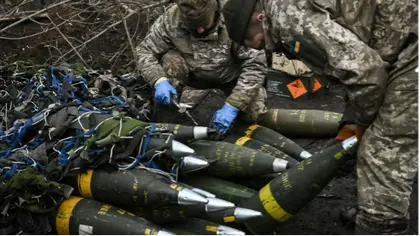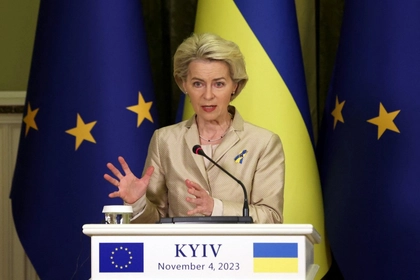A senior US official on Thursday said recently passed legislation by the US Congress doubled funding for acquisition of 155mm artillery shells, an ammunition category critically needed by Ukraine in its war with Russia, Washington news reports said.
Doug Bush, the chief weapons buyer for the US military, told the Reuters news agency that the Pentagon had requested Congress allocate $3.1 billion to purchasing 155mm shell manufacturing and investment in production capacity expansion, and that the actual figure allocated by US legislators was $6 billion.
JOIN US ON TELEGRAM
Follow our coverage of the war on the @Kyivpost_official.
Bush, in February comments, told Beltway media that the US government-led ramp up of domestic 155mm shell production is languishing at about 7,000 rounds a month.
In early 2022, prior to Russia’s full-scale invasion of Ukraine, it had already exceeded manufacturing expansion targets and accelerated to 36,000 shells a month, but Congressional delays in funding future production put more deliveries in jeopardy, Bush said.
“We appear to have gotten $6 billion. So that, I think, is a vote of confidence as we make our way to 100,000 shells a month,” Bush said on Thursday.
Combatants widely report Ukrainian forces are outshot by Russian artillery five shells to one because of burgeoning Kremlin production and ammunition manufacturing delays hitting Ukraine’s allies.

Kuleba Talks Peace in China – Bohdan Nahaylo
In the immediate wake of US President Joe Biden’s April 24 signature of a $61 billion military assistance bill – of which about half per Congressional instructions might be committed by the Pentagon to weapons or ammunition for the Ukrainian military – Ukrainian troops have seen ammunition shortages unchanged and continued to lose ground. In the Kremlin priority Avdiivka sector Ukrainian retreats have accelerated.
According to data compiled by the independent research and analysis group Lawfare, the US 155mm shell manufacturing capacity will probably reach a 60,000 shell/month capacity by the end of 2024 and is on track to close to double that by the end of 2025.
Although the figures are impressive, by most accounts Ukraine’s military – not the only user of US-produced artillery shells – needs about twice those volumes to have a solid chance of holding the Russian army at bay on all fronts, and four times more to dominate the battlefield and inflict defeats on Kremlin forces.

Failure to deliver sufficient shell to Ukraine’s gunners plays out directly on the battlefield, the report said.
“Last month, Ukrainian soldiers withdrew from the town [of Avdiivka], giving the Russian military their first victory since May 2023 by capturing a town that Ukraine had successfully defended since 2014. This happened primarily because the Ukrainians ran out of ammunition – specifically artillery munitions. Without artillery fire to disperse enemy troop concentrations, destroy enemy artillery systems, and disrupt the attacking forces’ supplies, Ukrainian forces could not hold their positions without incurring unsustainable losses.”
The German arms concern Rheinmetall, by far Europe’s largest 155mm shell manufacturer, likewise per Lawfare estimate will probably reach 60,000/month capacity by the end of 2024. Combined Finnish, Czech, Canadian and British manufacturer production targets, if all met, might add another 20,000 shells a month by the end of 2024, Lawfare research found.
Rheinmetall CEO Armin Papperger, in a March 14 interview with Sueddeutsche Zeitung, said that his company was gearing up to increase production of all major weapons categories and that by 2027 the firm should be producing 1.1 million 155mm shells a year thanks to a new production facility in Unterlüß, Lower Saxony, as well as in two planned 155mm shell plants in Ukraine and Lithuania.
The firm currently is filling a Bundeswehr order to deliver shell to Ukraine and has taken a new 40,000 shell order to be manufactured in Spain in 2025, he said.
Kremlin-controlled media have attacked German rearmament plans as threatening to Russia and destabilizing for Europe. Official Berlin has rejected the accusations and claimed Russian aggression against Ukraine and repeated nuclear threats against Europe leave Germany no choice but to rearm.

On April 29 unidentified persons set fire to a garden shed on property owned by Papperger in Lower Saxony.
A German-language statement published on the alternate journalism website Indymedia took credit for the arson attack and said they burned the garden shed because it was in Lower Saxony, and because of Papperberger’s alleged complicity in German warmongering and arms profiteering. German police were investigating.

The same day Papperger’s garden shed was burnt, the Czech national police announced they had uncovered a Russian spy ring responsible for attacks on Czech ammunition depots destroying tens of thousands of shells and killing two workers in October 2014.
Kremlin agents participating in the Czech operation also used poison to assassinate Sergei Srkypal, a former FSB agent who had defected, in a 2018 Salsbury Wiltshire attack, the Daily Telegraph and other British media reported.
In November 2023, a Bulgarian arms manufacturer sounded the alarm over continuous Russian sabotage against its arms manufacturing facilities – including causing multiple explosions – and alleged Russian infiltration into Bulgaria’s government.
There was also an explosion at a BAE Systems weapons manufacturing site in South Wales on Wednesday, April 17, though no suspicions of foul play at the time of the incident.
The day before, April 16, there was a fire at BAE Systems, in Scranton, Pennsylvania. Firefighters responded to a fire at the ammunition manufacturer General Dynamics, due to a fire that reportedly had started along the production line of the aging US factory.
You can also highlight the text and press Ctrl + Enter







